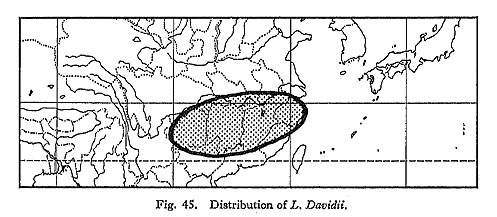Systematic Treatments
L. Davidii Franch.
Lespedeza Davidii Franch.Pl. David. 1: 94, t. 13 (1884)-Forbes & Hemsley in Journ. Linn. Soc. Bot. 23: 180 (1887)-Schindler in Engl., Bot. Jarhb. 49: 580 (1913); in Sargent, PL. Wils. 2: 107 (1914)-Hand.-Mazz., Symb. Sin. 7(3): 572 (1933)-Fu in Acad. Sin. Bot., Ill. Important Chin. Pl. Leguminosae, 522, fig. 516 (1955)-Acad. Sin. Bot., Iconogr. Cormophyt. Sin. 2: 460, fig. 2650 (1972).
Japanese name. Okushimohagi (Maekawa, 1966). A perennial plant, 2 m high. Stems ascending, most of terrestrial parts live a few years; branched in upper parts. Branches winged, ascending; when young with densely ascending or patent hairs. Distal parts of branch die in winter season, proximal parts (and stem) with axillary and winter buds. Leaves trifoliolate, petiolate, stipulate, spirally arranged. Stipules free, linear, 5 mm long, brownish, persistent. Petioles 2-5 cm long, with patent hairs. Terminal leaflets (at middle parts of branches) petiolulate; 3-8 cm long, 1.8-5 cm wide, entire, (broadly) elliptic, round at the base, retuse or obtuse at the apex (the apex itself with or without a point), upper surface densely pubescent, lower surface appressed-serice-ous; lateral ones similar to terminal but somewhat smaller. Inflorescence axillary racemous, one per axil, 3-12 cm long including the peduncle, 6-20-flowered. Primary bracts ovate, about 2-3 mm long, persistent; secondary bracts similar to primary ones. Flowers ca. 12 mm long at anthesis; pedicellate. Bracteoles at the base of the calyx narrowly ovate with acuminate apex, ca. 2 mm long, persistent. Calyx ca. 7.5 mm long, campanulate, deeply four-lobed, appressed pubescent; the upper calyx-lobe also deeply two-clefted as if calyx five-lobed; tube ca. 2.5 mm long; the lower lobes somewhat longest; lateral ones ca. 5 mm long, ca, 1 mm wide, triangular with acuminate apex. Standard subequal to (sometimes slightly shorter than) keel-petal and longer than wings, keel-petal longer than wings (K≥S>W). Standard ca. 11 mm long with distinct claw, 7 mm wide; lamina elliptic, round or refuse, inflexed-auriculate near the base; auricles broadly lunate; claw ca. 2 mm long. Wings ca. 10 mm long with distinct claw; lamina narrowly oblong, ca. 7mm long, ca. 3 mm wide, auriculate at upper basal part; claw ca. 3 mm long. Keel-petal ca. 11.5 mm long with distinct claw; lamina narrowly obovate, ca. 8.5 mm long, ca. 3 mm wide; claw ca. 3 mm long. Fruits compressed, broadly elliptic, ca. 8 mm long, 6 mm wide, subsessile, densely pubescent. Distr. China (Kiangsi, Chechiang, Kwangtung). Specimens examined. China. Kuei-chou (Torii, Oct. 6, 1902, TI). KIANGSI (Chianghsi). Lushan (M. Takahashi 24, TI; Cheng 206, TI); Tuchang (F. Maekawa in 1941, TI). KWANGTUNG. Yang Shan Distr., south of Linchow, Yang Shan, and vicinity (T. M. Tsui 598, TI). CHECHIANG. Hangchou (K. Kimura s.n., TI). This species is characterized by its large, roundish leaflets with dense hairs, distinctly branches, and triangular calyx-lobes with acuminate apices. This is a distinct species in the series Macrolespedeza. Lespedeza sect. Heterolespedeza Nakai in Jourm. Jap. Bot. 15: 531 (1939). Small shrub; scales of winter-buds and also foliage leaves arranged distichously. Type species: L. Buergeri Miquel (Nakai, 1939).
|



